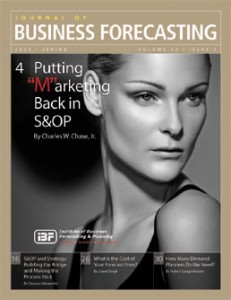Volume 32 Issue 1
Spring 2013
Click here to DOWNLOAD a sample copy of the latest Journal of Business Forecasting (JBF)
Click here to become an IBF member and get a JBF subscription FREE
FEATURED ARTICLES:
Putting “M”arketing Back in S&OP
By Charles W. Chase, Jr.
Smart organizations share common goals and performance metrics. They are also nimble and work collaboratively, focusing on sustainable strategic objectives. They take a more balanced approach that looks horizontally across the supply chain, virtually eliminating silos and optimizing the process from market-to market and supplier-to-supplier’s supplier. The new focus on the value supply chain is how companies can listen to their customers, assess the market, and then create a more accurate demand response.
S&OP and Strategy: Building the Bridge and Making the Process Stick
By Duncan Alexander
Sales and Operations Planning has come a long way since its invention in the 1980s as a process to align sales and manufacturing volumes. But after early success, the process often falters. This article explains why building a strong bridge between strategy and S&OP will drive successful strategy execution and help build S&OP into the culture.
Developing Complete Software Business Cases
By Larry Lapide
This column discusses the performance elements that ought to be considered in a business case that is developed to justify the implementation of software systems. It espouses the estimation of benefits and costs in three areas of operational improvement: Efficiency, Asset Utilization, and Customer Response. This complete and holistic view is especially needed when justifying the purchase of forecasting and planning software systems.
What Is the Cost of Your Forecast Error?
By Sumit Singh
Forecast Accuracy, a metric that permeates throughout a company’s multi-faceted functions, impacts both the top-line sales revenue and the bottom-line profit margin. Even though managers of organizations are well aware of it, they are reluctant to go through the rigor required to reap its full benefit. This article explores why many organizations and their managers fail to fully capitalize on forecast-accuracy information and what can be done to change it.
How Many Demand Planners Do We Need?
By Robert Langenhuizen
There is no simple way to decide how many demand planners a company needs. The author posits and discusses six essential factors to consider when determining the answer: What is expected from a demand planner? What kind of demand planning process is in place? How many forecasts have to be prepared, and what level of detail is required? How much accuracy is needed? What kind of forecasting technology is available to do the job?
Book Review
By Chaman L. Jain
“Bricks Matter”: The Role of Supply Chains in Building Market-Driven Differentiation By Lora M. Cecere and Charles W. Chase, Jr.
From a Soft Patch to Recession for Industrial Countries
By Evangelos Otto Simos
The U.S. Economy…Stuck in Low Gear
By Jack Malehorn
Answers to Your Forecasting Questions
By Chaman L. Jain
Click here to become an IBF member and get a JBF subscription FREE
The Journal of Business Forecasting (JBF) has been providing demand planning, forecasting, supply chain, and S&OP practitioners with jargon-free articles on how to improve the value of their roles and company performance from improved forecasting and planning for over 30 years. A subscription to the JBF comes with IBF membership at no additional cost.


